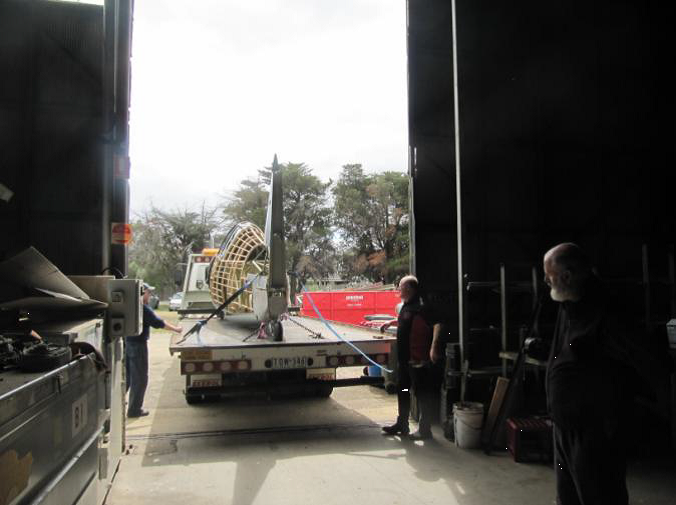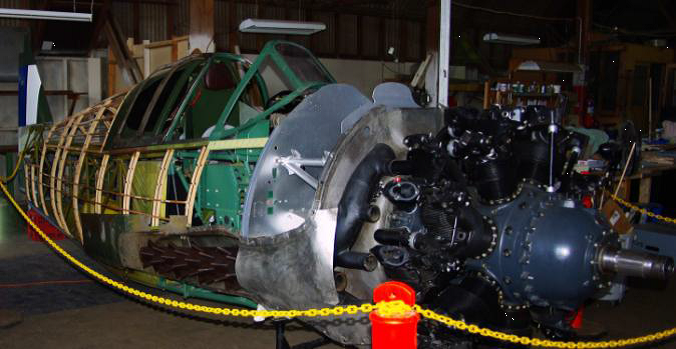February, 2015
A new year, new people and lots of problems to solve. We held the first meeting of the new Committee in December and have settled in to the allotted responsibilities.
Heritage has still not made a decision. This is holding us up but, unfortunately, we cannot move until we have that authority. Heritage has 60 days to deliberate after they have received the required information. They are still asking for further information. So, even though we have the land and the hangar we have to wait on the go-ahead from Heritage before we can start to implement our plans.
Werribee Airfield, Victoria, during WW2
Werribee Airfield was built in early 1940 as a satellite field to Pt Cook and Laverton. It was used for the storage of aircraft produced by CAC at Fisherman’s Bend until required by the RAAF for night fighter operations. It had an all over grass runway area with no defined runways,
Werribee Airfield was also used for the assembly of aircraft coming from the UK as was the International Farm Machinery factory at Geelong.
There were 5 large hangars built at Werribee which still existed in 2000. The 2 nearest the main road were added to the National Heritage Register late October 2000. This was due to the unique trusses used in the construction of the buildings.
Werribee was home to a number of RAAF Repair and Salvage type units during WW2 including:
Central Recovery Depot
9 Repair and Salvage Unit (9RSU)
12 Aircraft Repair Depot (12ARD)
22 Repair and Salvage Unit (22RSU)
26 Repair and Salvage Unit (26RSU)
As a result of these units being based at Werribee many wrecked planes were brought there. Apparently there were still many of these wrecks left at the rear of the airfield at the end of WW2 including some Japanese aircraft possibly including an Oscar from Eagle Farm Airfield in Brisbane and 2 German aircraft.
After the war the field was used as a disposal dump for aircraft no longer required and many fine planes were broken up. It was also used as a source of aircraft for the various firing ranges that operated up until the late 1950s.
There are stories of possible buried aircraft at Werribee Field.
At the end of the war Air Vice Marshall George Jones ordered that 2 of every aircraft that had served with the RAAF be stored at Werribee for later use in a museum that he wanted built. This project started and some 200 aircraft were taken there. But unfortunately some time in 1948 a supply officer made an error and gave the order for them to be broken up. Australia and the RAAF lost a valuable collection.
In Memorium
In January John Balas, a long time hangar worker, died unexpectedly. John was a talented tradesman and his work on the rear of A72-176 was meticulous.
John will be sadly missed.
Heritage Festival
A request:
As reported earlier we are presenting, in May, the story of the Liberators’ involvement in the repatriation of POWs back to Australia at the end of the war. This is the basis of the display we are putting on as part of the National Trust Heritage Trail.
We have arranged for 4 speakers, serving at the time, to tell their stories but also want to collect and present as many written memoirs as possible.
Some reports from veterans have already been collected and they make for fascinating reading. This little known aspect of the work of Liberators needs to be told. We will incorporate some of the memoirs into a purpose built audio/visual cabinet which will be used to present information in a readily accessible form.
If you were involved we would appreciate hearing from you. We need written or oral memories, copies of relevant logbook pages and any other information that may be of interest.
We were also successful in our application to have the services of a Roving Curator. Kitty Owens has been appointed to assist in the presentation of this display. She will visit the hangar in March.
We have also been approached by the National Trust to supply information so that they can put an article about the repatriation process in their magazine. They see this work being of great historical importance.
Personnel Changes
Ron and Kay Taaffe have left the hangar to start a new phase in their lives in northern NSW.
Ron was the Liberator Co-ordinator and a long time Committee member who served on the sub-committee working with Melbourne Water and Places Victoria to ensure our future at the present site. Kay worked in the shop and managed the ordering. Both were heavily involved in organising and running catering for visiting groups.
They’ve left big shoes to fill. We wish them happiness in their new life.
John Morrissy has been appointed Liberator Co-ordinator.
Liberator Update (John Morrissy)
Festive season over: progress on the Liberator continues!
Work is continuing on remaking part of the underwing panels. This includes anchor nut strips being fitted to the wing; a tedious job.
Refurbishment of the oxygen system is continuing in the rear fuselage. Hydraulic piping for the flaps and undercarriage has been fitted on the left hand rear wing spar. Fittings for control cables on the rear wing spar continue to be made and installed. The aileron and flap fittings in the fuselage are temporarily removed for the wing cleaning. The makeup and installation of control and electrical/instrument cable looms is progressing for No. 3 and 4 engines.
The cleaning and treating of the wing centre section, externally and internally, to inhibit corrosion and provide a protective coating is the next major work. Several methods are currently being investigated to determine which will give the best long term finish.
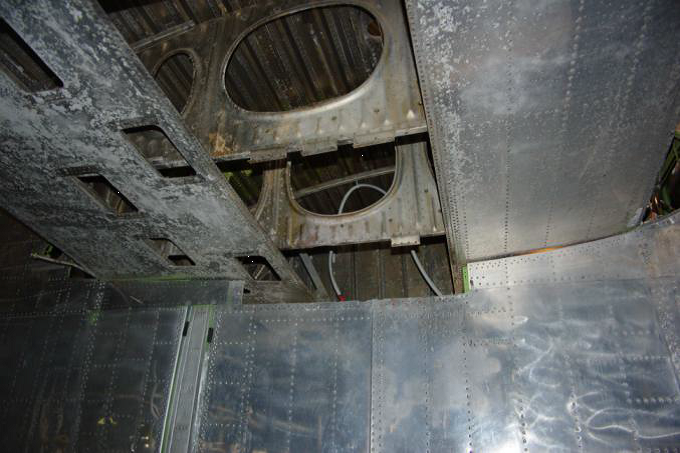
Interior of the wing: in need of some TLC.
As for the turrets, Ron Taaffe has handed over the rear turret to Jim Johnson to continue fitting the perspex, the gun shields and other components to complete that work. For the front turret a number of components are being made: doors, armour glass mountings and fittings necessary for correctly mounting the turret to the aircraft. The display turret has a problem with the elevation gear box and will have to be dismantled so corrections can be made. Work on the saddle is just about completed so that will be fitted on the aircraft in the near future.
We also have the original "tub" that fits under the turret which is in poor condition but can be restored. This component was not included in the front section that is now part of the fuselage but can be retrofitted.

Scrap metal
The hangar clean out continues at a rapid pace with a huge amount of accumulated debris and non-aircraft items heading for the scrap man. We’ve already had "wows’" of appreciation from some regular visitors.
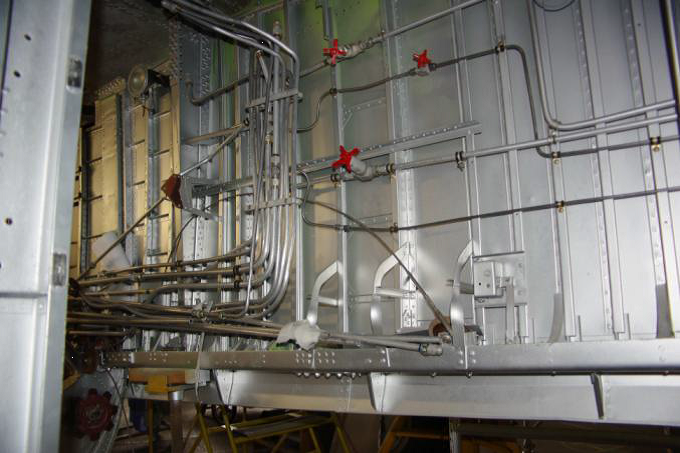
Hydraulics in the bomb bay
Oxford Update (Ken Hindle)
Many visitors to the hangar have seen the progress being made on the Oxford and have shown a great deal of interest. One such person was so interested that he asked to join us and we accepted on the spot. His name is Alan Harrison and he’s been with us now for 3 weeks. Welcome Alan.
Some parts in the construction of the wing section are time consuming in that every little piece has to be handmade to quite tight tolerances but the challenge is taken and the next one started: very satisfying.
One of the noticeable things, of course, is the room being taken up by the Oxford as we progress but the hangar crews are doing their best to make that room available. Thanks for that.
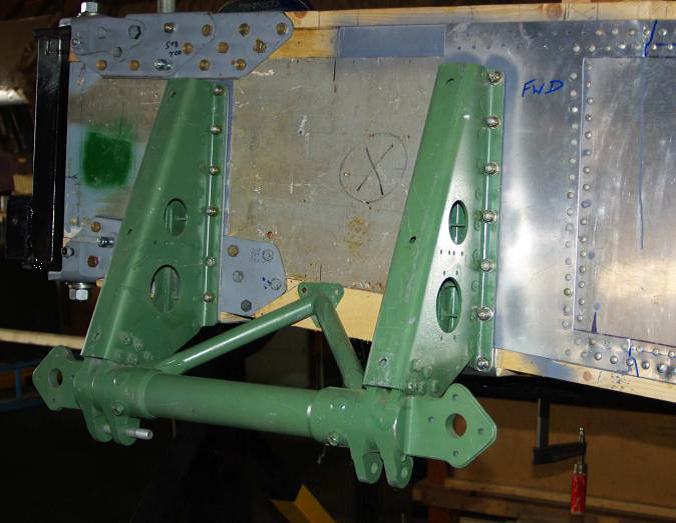
Some of the time consuming work on the Oxford.
New Recruit
Recently acquired a new worker. Tom a 15 year old school boy with an avid interest in aviation has joined the team. He’s working at the hangar each Sunday and during school holidays. Good to get ‘em young!
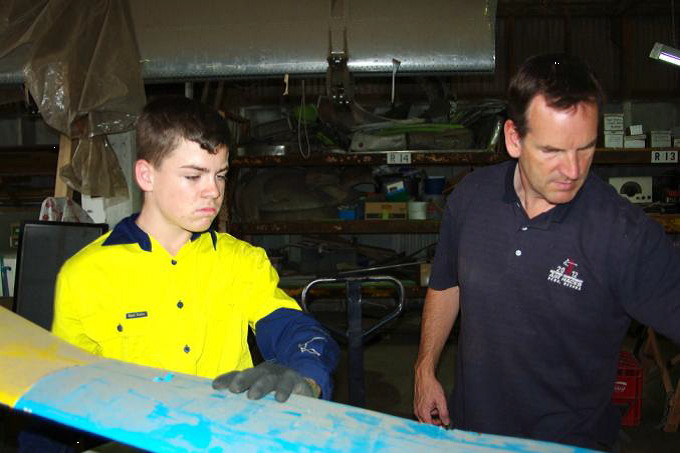
Tom being instructed by our Vice President Ken Abbott.
We’re getting close to having 2,000 "followers". They were recently asked what information they wanted to see on our page. Three choices were offered:
Information on the restoration process and future plans;
Information on other activities, eg Oxford; and,
History of RAAF B-24 ops.
Consensus was: they wanted all three and, as well wanted to know about the volunteers. So we are starting a new segment… a picture of the volunteer and some information about where he/she works in the hangar.
Hangar Update
Another aircraft has arrived in the hangar - and has already attracted lots of interest from the visitors we’ve been getting through Avalon Week. Nick Knight, the owner of the Boomerang, has been building it - a restoration of A46-147 - at his home for several years. The project has out-grown its surroundings so we will display it in the hangar while Nick continues to work on it. He is really happy that his plane now has a safe home.
The CAC Boomerang was a WW2 fighter aircraft designed and built in Australia between 1942 and 1945. Most of the aircraft used by the RAAF were sourced from either the UK or USA, but as the war progressed the problems associated with getting planes from overseas proved difficult.
CAC had a production factory at Fisherman’s Bend in Melbourne. Lawrence Wackett, General Manager at CAC recruited Fred David to design a new fighter aircraft.
This aircraft proved to be fast and manoeuvrable at heights below 15,000 feet. It proved to be a valuable tool as a light ground attack aircraft. It was highly successful in a close support role. The Boomerang Squadrons supported bombing raids by our Liberators. The Boomerang was the only aircraft designed and built in Australia that has been involved in active war service.
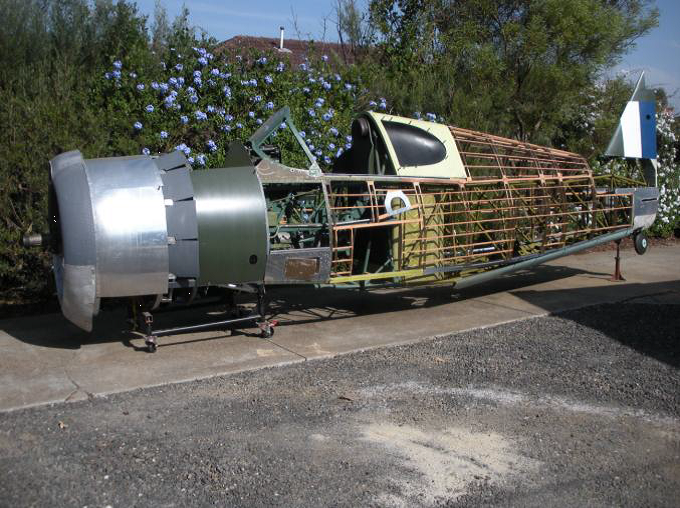
Nick’s Boomerang.

WW2 Boomerang
NB: A local tow truck operator, Godwin Zerafa from Werribee Accident Repair Centre, did the transporting for free; a great thing to do.
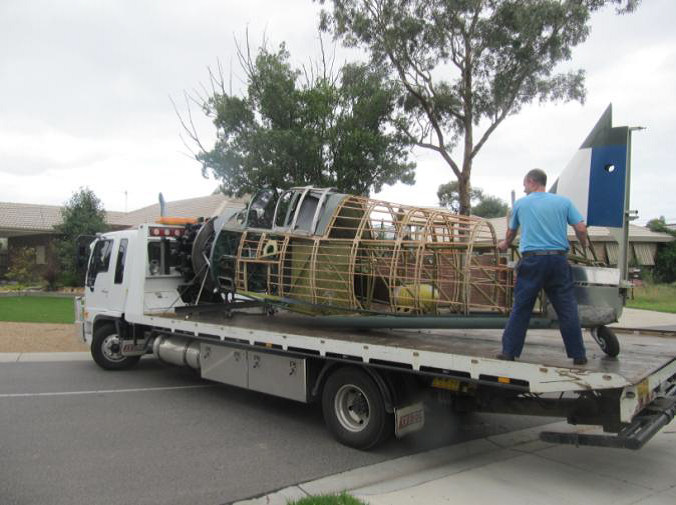
Visitor Numbers
In 2014 we had 2810 visitors to the hangar; 107 from overseas, the rest from Australia. These numbers are down on 2013 but our numbers increase overall when it’s an Avalon Airshow Year.
Most of our visitors come from Victoria.
We continue to rely heavily on group visits. Probus Clubs have continued to support us as have car clubs. If you belong to an organisation please let your group know that we welcome group visits. We can provide morning/afternoon teas at a small extra cost.
The Bayonet Club of Modellers who have their annual competition/swap meet in November raise a large amount of money which is donated totally to the B-24. We thank them for their ongoing support.
Engine runs continue to attract visitors.
2015 is an Avalon Air Show year and we get many visitors from that. As usual, during Avalon Week the hangar will be open every day, Tuesday 24th February to Sunday 1st March from 9.30 am to 5.30 pm.
On Sunday, 1st March we will have an engine run at 11 am.
We won’t be taking a display to Avalon but some of our artefacts will be used to form a display put on by the Living History Group. If you’re at Avalon look in and see them. Their display will be an interesting one.
Time to laugh!
I thought I wanted a career. Turns out I just wanted to be paid.
Behind every successful man is a woman: behind the fall of a successful man is usually another woman!
To steal ideas from one person is plagiarism; to steal from many is research.
